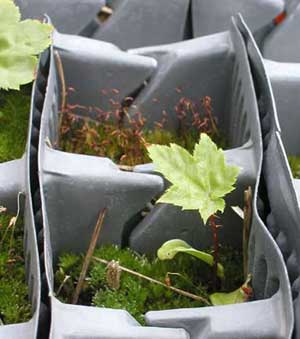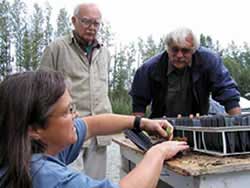 by Sonya Senkowsky November 8, 2003
If you've ever tangled with the common Alaska weed known as devil's club, you don't have to ask how it got that name. In some areas, the plant grows as tall as seven or eight feet.
Alaska agronomist Peggy Hunt said, "It's funny because the scientific name for it is Oplopanux horridus. Think of horrid." Hunt is a plant ecologist at the state-run Native Plant Nursery, in Palmer, Alaska, which is dedicated to finding the most effective ways to propagate and raise native plants-including devil's club. Hunt said, "And then, hopefully, we'll be able to give the native plants to commercial growers, who will then be able to take those parent plants and sell them to people who may want them." Why would anyone want devil's club? The same thorns that make Oplopanax horridus so, well, horrid, could make it attractive to others, says Stoney Wright, manager of the Alaska Plant Materials Center, also in Palmer. Wright said, "Early on, there was interest by the Division of Parks for ways of keeping people on trails, and that's when we first started looking at devil's club. If you can keep people concentrated on the trails with something natural that everyone respects and tries not to wander into, it would be devil's club." Add to this the fact that devil's club, related to ginseng, has long been used in Alaska Native medicines, and some think it may hold chemical cures for a variety of ailments, a possibility researchers elsewhere are actively investigating. Peggy Hunt says devil's club could hold untold promise. Hunt said, "You know, it's kind of like in the rainforest, and you realize that there's so many plants or insects there that may never have been discovered, and one of those plants might have the chemical that you need to cure cancer. Well, here we're looking at the devil's club and it may be something that can help with tuberculosis, or with diabetes, or lots of different things." But the state-run nursery isn't looking for miracle cures. Its plant scientists are just trying to figure out how to grow devil's club from seed. That way, they can ensure a sustainable
"It seems to take two years for the devil's club to go from a seed into a sturdy seedling of maybe an inch high. And we're trying to make this go a little faster. So instead of it taking two years, we want it to go in one year," said Hunt. Growing a devil's club plant is not easy. First, the seeds, which are contained in clumps of red berries on top of the plant, need to be extracted from the fruit. The immature seeds are cleaned, to help duplicate the maturing process that would occur in the wild. Hunt said they have lots of instruments for cleaning seed. Finally, the seeds are rinsed in running water for 72 hours, a process that helps soften them. After being cleaned, the seeds are planted in flats kept alternately in refrigerators and greenhouses to simulate Alaska's seasons. Seeds harvested this fall will be put on an accelerated schedule, says Hunt. With luck, the next batch of plants will pop up their thorny little stems in just over a year. Among those eager to see the results will be freelance plant prospector David Smith. A retired Alaska city manager, Smith got excited about devil's club after meeting a scientist in Hong Kong who told him a related plant had been harvested nearly to extinction in Asia. With the aid of grants, Smith has been exploring whether Alaska devil's club could be sold to the Asian market. Smith said, "The state estimates we have 55,000 acres here. China and Russia combined never had 5,000, but they did use it as a medicine and almost wiped it out. I think this is a hidden asset in Alaska that's been overlooked."
Source of News Release:
|
|||

